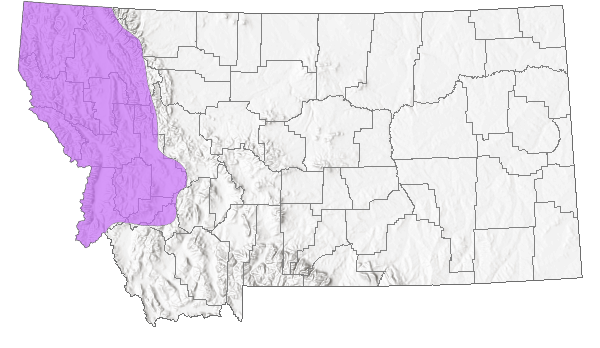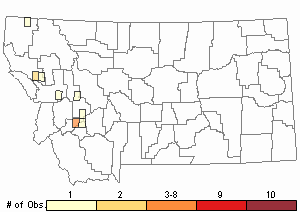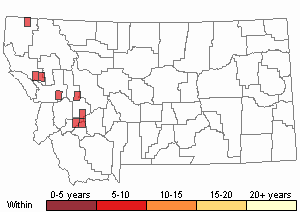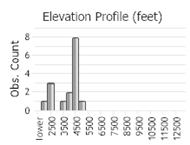View in other NatureServe Network Field Guides
NatureServe
Montana
Utah
Wyoming
Idaho
Wisconsin
British Columbia
South Carolina
Yukon
California
New York
Oblique-lined Tiger Beetle - Cicindela tranquebarica vibex
Other Names:
Cicindela tranquebarica borealis
General Description
The following is taken from Wallis (1961), Kritsky and Horner (1998), and Pearson et al. (2015), including description of C. t borealis. Body length is 12-15 mm, variable in size but one of the larger forms. Color above is brown, green, dull coppery-green to dark brown, black, or dark green. Maculations are complete and usually relatively thin, the oblique shoulder (humeral) maculation running toward the midline with the rear tip not expanded, sometimes reduced to a short or broken line (vibex); sometimes a partial marginal band on the outer edge of the elytra. Ventral surfaces metallic green and copper to purple on abdomen (borealis), or metallic green to purple (vibex). Hairy forehead with erect setae, short upper lip, labrum short with 3 teeth.
Phenology
Tiger beetle life cycles fit two general categories based on adult activity periods. “Spring-fall” beetles emerge as adults in late summer and fall, then overwinter in burrows before emerging again in spring when mature and ready to mate and lay eggs. The life cycle may take 1-4 years. “Summer” beetles emerge as adults in early summer, then mate and lay eggs before dying. The life cycle may take 1-2 years, possibly longer depending on latitude and elevation (Kippenhan 1994, Knisley and Schultz 1997, Leonard and Bell 1999). Adult Cicindela tranquebarica vibex (= borealis) a spring-fall beetle found April-October (Larochelle and Larivière 2001). In Montana probably varies with elevation, reported (as C. t. borealis) from late March to mid-September (Nate Kohler personal communication).
Diagnostic Characteristics
The following come largely from Wallis (1961), Kritsky and Horner (1998), Acorn (2001), and Pearson et al. (2015) for
Cicindela tranquebarica vibex (= borealis). For our region, the long obliquely-descending arm of the shoulder (humeral) maculation on the dark elytra differentiates this from all other tiger beetle species.
C. t. vibex (= borealis) differs from
C. t. kirbyi, the other subspecies of Oblique-lined Tiger Beetle in Montana, by being dark brown, dark green, or black above with thin maculations (including a thin shoulder maculation that may be short or broken), instead of dark brown with a relatively thick and unbroken shoulder maculation. Intergrades of the two subspecies may occur west of the Continental Divide. Validity of several subspecies designations are in need of reevaluation (Sumlin 1976, Shook 1984, Kippenhan 1994, Kritsky and Horner 1998, Acorn 2001, Knisley and Haines 2007, and Pearson et al. 2015) although
C. t. vibex is accepted by all authorities but not with the same distribution. Validity of
C. t. borealis is questioned by Pearson et al. (2015) but which they include as a subspecies separate from
C. t. vibex, and with a range touching Montana.
Species Range
Montana Range
Range Descriptions

 Native
Native
Range Comments
Cicindela tranquebarica vibex (= borealis) is found west of the Continental Divide in the U.S. and Canada. The borealis form reported throughout the Great Basin and overlaps with C. t. kirbyi in eastern British Columbia, Idaho, and western Montana. C. t. borealis may represent intergrades with vibex in our region, not a distinct subspecies (Kritsky and Horner 1998, and Pearson et al. 2015). Intergradation with other subspecies makes range limits and subspecies determinations uncertain. In Montana, reported (sometimes as C. t. borealis) west of the Continental Divide in appropriate habitats, to at least 5352 ft. (1631 m) elevation (Nate Kohler personal communication). Distribution west of the Continental Divide needs additional study and documentation.
Observations in Montana Natural Heritage Program Database
Number of Observations: 18
(Click on the following maps and charts to see full sized version)
Map Help and Descriptions
Relative Density

Recency



 (Observations spanning multiple months or years are excluded from time charts)
(Observations spanning multiple months or years are excluded from time charts)
Migration
Non-migratory but capable of dispersal. When wings are fully developed (macropterous), it is a strong agile flier and fast runner (Larochelle and Larivière 2001).
Habitat
Adult and larval tiger beetle habitat essentially identical, the larvae live in soil burrows (Knisley and Schultz 1997). Across the range, Cicindela tranquebarica vibex (= borealis) occurs in a variety of habitats including beaches, mud flats along lakes, saline and alkali flats, ponds, streams, sagebrush, dry lake beds, irrigated pastures, ditches, roads near lakes, forest openings, river sandbars (Wallis 1961, Acorn 2001, Larochelle and Larivière 2001, Pearson et al. 2015, and Sauder 2017). In Montana, documented habitats include ditches, sand pits, riverine dunes, sand flats near ponds, old river crossings and fishing access sites, sparse creek-side vegetation (Nate Kohler personal communication).
Food Habits
Larval and adult tiger beetles are predaceous. In general, both feed considerably on ants (Wallis 1961, and Knisley and Schultz 1997). Cicindela tranquebarica vibex diet is not described but probably includes a variety of small insects and spiders for both the larvae and adults (Larochelle and Larivière 2001).
Ecology
Larval tiger beetles live in burrows and molt through three instars to pupation, which also occurs in the larval burrow. Adults make shallow burrows in soil for overnight protection, deeper burrows for overwintering. Adults are sensitive to heat and light and most active during sunny conditions. Excessive heat during midday on sunny days drives adults to seek shelter among vegetation or in burrows (Wallis 1961, and Knisley and Schultz 1997).
Cicindela tranquebarica vibex has a broad range of ecological tolerance (eurytopic). Adults are diurnal, and gregarious (Larochelle and Larivière 2001). Noted hiding during the night under dry cow chips. Predators of adults are not described but probably include birds and robber (asilid) flies. Larval parasites probably include bombyliid flies. Escapes by flying slowly short distances (3-5 m), turns to face pursuer once landing then seeks cover quickly (Larochelle and Larivière 2001). Associated tiger beetle species include
Cicindela columbica,
C. hirticollis,
C. oregona,
C. repanda (Sauder 2017).
Reproductive Characteristics
Life cycle of Cicindela tranquebarica vibex is probably 2 years, with both third instar larvae and tenerals (fresh adults) overwintering (Acorn 2001, Larochelle and Larivière 2001, and Pearson et al. 2015). Little information on many reproductive characteristics, but probably similar to other subspecies (see the full species account). Mating probably May to August (Larochelle and Larivière 2001). Females typically oviposit in sites where the water table is near the ground surface, often in moist, sandy soil that is sparsely vegetated and contains some humus. Larval burrows dug in saltgrass areas. Tenerals probably appear in August then overwinter, reemerge the following spring to mate. Duration of larval life probably 12-15 months, of adult life about 11 months (Criddle 1907, 1910, and Larochelle and Larivière 2001). No information for Montana.
Management
Not considered rare or in need of special conservation management overall (Knisley et al. 2014). Benefits from many man-made habitats, including agricultural fields and pastures, rangelands, sand and gravel pits, clay roads, powerline corridors. Native habitats favored by this species experience vegetation encroachment and stabilization as succession proceeds, especially from shrubs and trees which cast too much shade on larval burrows, and benefit from disturbance that retains a variety of succession conditions. Some colonies (particularly the larval burrows) could be impacted by trampling through livestock overgrazing, but grazing at appropriate times and stocking levels could also be beneficial by keeping vegetation cover more open (Knisley 2011). Prescribed fire is also a useful tool for maintaining a variety of successional conditions in appropriate situations (Winton 2010).
Stewardship Responsibility
References
- Literature Cited AboveLegend:
 View Online Publication
View Online Publication Acorn, J. 2001. Tiger beetles of Alberta: killers on the clay, stalkers on the sand. The University of Alberta Press, Edmonton, Alberta. 120 p.
Acorn, J. 2001. Tiger beetles of Alberta: killers on the clay, stalkers on the sand. The University of Alberta Press, Edmonton, Alberta. 120 p. Criddle, N. 1907. Habits of some Manitoba 'tiger beetles' (Cicindela). Canadian Entomologist 39:105-114.
Criddle, N. 1907. Habits of some Manitoba 'tiger beetles' (Cicindela). Canadian Entomologist 39:105-114. Criddle, N. 1910. Habits of some Manitoba tiger beetles (Cicindelidae). Canadian Entomologist 42(2):9-15.
Criddle, N. 1910. Habits of some Manitoba tiger beetles (Cicindelidae). Canadian Entomologist 42(2):9-15. Kippenhan, Michael G. 1994. The Tiger Beetles (Coleoptera: Cicindelidae) of Colorado. 1994. Transactions of the American Entomological Society 120(1):1-86.
Kippenhan, Michael G. 1994. The Tiger Beetles (Coleoptera: Cicindelidae) of Colorado. 1994. Transactions of the American Entomological Society 120(1):1-86. Knisley, C.B. 2011. Anthropogenic disturbances and rare tiger beetle habitats: benefits, risks, and implications for conservation. Terrestrial Arthropod Reviews 4:41-61.
Knisley, C.B. 2011. Anthropogenic disturbances and rare tiger beetle habitats: benefits, risks, and implications for conservation. Terrestrial Arthropod Reviews 4:41-61. Knisley, C.B. and R.D. Haines. 2007. Description and conservation status of a new subspecies of Cicindela tranquebarica (Coleoptera: Cicindelidae), from the San Joaquin Valley of California, U.S.A. Entomological News 118(2):109-126.
Knisley, C.B. and R.D. Haines. 2007. Description and conservation status of a new subspecies of Cicindela tranquebarica (Coleoptera: Cicindelidae), from the San Joaquin Valley of California, U.S.A. Entomological News 118(2):109-126. Knisley, C.B., and T.D. Schultz. 1997. The biology of tiger beetles and a guide to the species of the south Atlantic states. Virginia Museum of Natural History Special Publication Number 5. 210 p.
Knisley, C.B., and T.D. Schultz. 1997. The biology of tiger beetles and a guide to the species of the south Atlantic states. Virginia Museum of Natural History Special Publication Number 5. 210 p. Knisley, C.B., M. Kippenhan, and D. Brzoska. 2014. Conservation status of United States tiger beetles. Terrestrial Arthropod Reviews 7:93-145.
Knisley, C.B., M. Kippenhan, and D. Brzoska. 2014. Conservation status of United States tiger beetles. Terrestrial Arthropod Reviews 7:93-145. Kohler, Nathan S. Excel spreadsheets of tiger beetle observations. 6 August 2022.
Kohler, Nathan S. Excel spreadsheets of tiger beetle observations. 6 August 2022. Kritsky, Gene and Leslie Horner, 1998. Geographic variation in Cicindela tranquebarica Herbst (Coleoptera: Cicindelidae). Cicindela 30 (3-4): 13-32.
Kritsky, Gene and Leslie Horner, 1998. Geographic variation in Cicindela tranquebarica Herbst (Coleoptera: Cicindelidae). Cicindela 30 (3-4): 13-32. Larochelle, A and M Lariviere. 2001. Natural history of the tiger beetles of North America north of Mexico. Cicindela. 33:41-162.
Larochelle, A and M Lariviere. 2001. Natural history of the tiger beetles of North America north of Mexico. Cicindela. 33:41-162. Leonard, Jonathan G. and Ross T. Bell, 1999. Northeastern Tiger Beetles: a field guide to tiger beetles of New England and eastern Canada. Boca Raton, FL: CRC Press. 176 p.
Leonard, Jonathan G. and Ross T. Bell, 1999. Northeastern Tiger Beetles: a field guide to tiger beetles of New England and eastern Canada. Boca Raton, FL: CRC Press. 176 p. Pearson, D.L., C.B. Knisley, D.P. Duran, and C.J. Kazilek. 2015. A field guide to the tiger beetles of the United States and Canada, second edition. New York, NY: Oxford University Press. 251 p.
Pearson, D.L., C.B. Knisley, D.P. Duran, and C.J. Kazilek. 2015. A field guide to the tiger beetles of the United States and Canada, second edition. New York, NY: Oxford University Press. 251 p. Sauder, J.D. 2017. Status update of Cicindela columbica (Hatch) (Coleoptera: Carabidae: Cicndelinae) in Idaho. The Coleopterists Bulletin 71(3):631-634.
Sauder, J.D. 2017. Status update of Cicindela columbica (Hatch) (Coleoptera: Carabidae: Cicndelinae) in Idaho. The Coleopterists Bulletin 71(3):631-634. Shook, G.A. 1984. Checklist of tiger beetles from Idaho (Coleoptera: Cicindelidae). Great Basin Naturalist 44(1):159-160.
Shook, G.A. 1984. Checklist of tiger beetles from Idaho (Coleoptera: Cicindelidae). Great Basin Naturalist 44(1):159-160. Sumlin, W.D. III. 1976. Notes on the tiger beetle holdings of the Nevada state Department of Agriculture (Coleoptera: Cicndelidae). The Coleopterists Bulletin 30(1):101-106.
Sumlin, W.D. III. 1976. Notes on the tiger beetle holdings of the Nevada state Department of Agriculture (Coleoptera: Cicndelidae). The Coleopterists Bulletin 30(1):101-106. Wallis, J.B. 1961. The Cicindelidae of Canada. Toronto, Ontario, Canada: University of Toronto Press. 74 p.
Wallis, J.B. 1961. The Cicindelidae of Canada. Toronto, Ontario, Canada: University of Toronto Press. 74 p. Winton, R.C. 2010. The effects of succession and disturbance on Coleopteran abundance and diversity in the Centennial Sandhills. M.Sc. Thesis. Montana State University. Bozeman, MT. 77pp + Appendices.
Winton, R.C. 2010. The effects of succession and disturbance on Coleopteran abundance and diversity in the Centennial Sandhills. M.Sc. Thesis. Montana State University. Bozeman, MT. 77pp + Appendices.
- Additional ReferencesLegend:
 View Online Publication
View Online Publication
Do you know of a citation we're missing? Bousquet, Yves. 2012. Catalogue of Geadephaga (Coleoptera; Adephaga) of America north of Mexico. ZooKeys. 245:1-1722.
Bousquet, Yves. 2012. Catalogue of Geadephaga (Coleoptera; Adephaga) of America north of Mexico. ZooKeys. 245:1-1722. Pearson, D.L., C.B. Knisley, and C.J. Kazilek. 2006. A field guide to the tiger beetles of the United States and Canada: identification, natural history, and distribution of the Cicindelidae. Oxford University Press, New York, New York. 227 pp.
Pearson, D.L., C.B. Knisley, and C.J. Kazilek. 2006. A field guide to the tiger beetles of the United States and Canada: identification, natural history, and distribution of the Cicindelidae. Oxford University Press, New York, New York. 227 pp.
- Web Search Engines for Articles on "Oblique-lined Tiger Beetle"
- Additional Sources of Information Related to "Insects"





